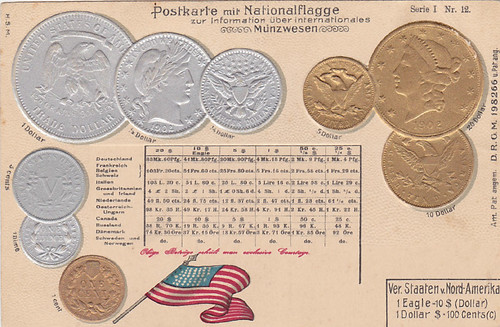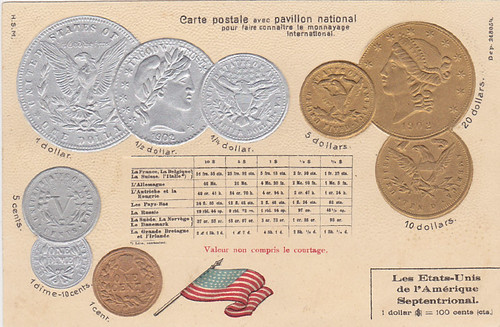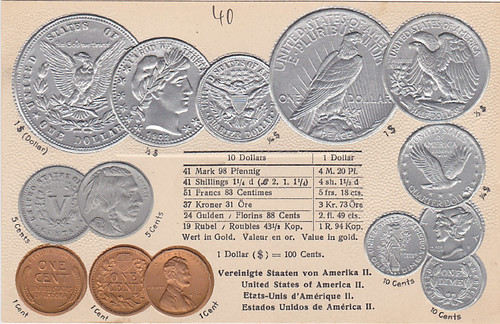
PREV ARTICLE
NEXT ARTICLE
FULL ISSUE
PREV FULL ISSUE
NUMISMATIC POSTCARDS PICTURING U.S. COINS
David Gladfelter forwarded this follow-up on our discussion of numismatic postcards. Thanks!
-Editor
These cambist postcard discussions in The E-Sylum are starting to get me enthused again about the topic. Here are a few comments specifically about cards of the United States. Hugo Semmler produced U.S. cards using four different embossing dies. (Numerous printing varieties occur with each die, as well, most noticeably the language of the inscriptions.) What appears to be the earliest die shows the reverse of a U. S. trade dollar in the upper left corner. It even has the S mint mark. Early on, the dollar image on the die was changed to the Morgan reverse, without a mint mark. The rest of the die is unchanged. The whole die was then remade with the same images. Notice that the word DOLLAR is now tiddlywinked by the half dollar so that only DOLLA shows. Ditto for the $20 – the three lowest stars on the left are similarly “eclipsed.” (This is the die used to make Frank Drascovic’s card; his version has English printing, mine has French, but they come from the same embossing die.) Finally, another die remake occurred with the lowest star on the left of the $20 reappearing. Further changes to the U. S. cards were made by subsequent publishers. By 1930 there were two different U. S. cards, one for gold coins and one for silver and minor coins.

Semmler U.S. Embossing Die #1

Semmler U.S. Embossing Die #2

Semmler U.S. Embossing Die #3

Semmler U.S. Embossing Die #4 I noticed on Semmler die 4 is the addition of an image of the gold dollar (with 1853 date on the obverse) at lower right. Artistic license? There are many back varieties to the cambist cards. They come divided and undivided, tête-bêche and straight up -- in German, French, Italian, English, Hungarian, Dutch, Spanish, Czech, Afrikaans, Russian, Portuguese, Romanian, some I don't recognize (Karta korespondencnyjna, Korespondencni listek, Correspondenzkarte)and multilingual. The backs can serve as clues to classifying the cards, which is quite a job. Takers? Below is the two-card set. The maker is Walter Erhard of Waiblingen-Stuttgart. Erhard took over from Max Heimbrecht in the mid 1920s.
 Erhard U.S. postcard #1 of 2
Erhard U.S. postcard #1 of 2
 Erhard U.S. postcard #2 of 2
Erhard U.S. postcard #2 of 2
Wow - who knew there were so many varieties of these to collect!? Not me. Now we all do. So be on the lookout for these, folks! Thanks again, David.
-Editor
To read the earlier E-Sylum article, see:
MORE ON NUMISMATIC POSTCARDS
(www.coinbooks.org/esylum_v17n04a19.html)
The Numismatic Bibliomania Society is a non-profit organization promoting numismatic literature. See our web site at coinbooks.org. To submit items for publication in The E-Sylum, write to the Editor at this address: whomren@gmail.com To subscribe go to: https://my.binhost.com/lists/listinfo/esylum All Rights Reserved. NBS Home Page Contact the NBS webmaster 
|